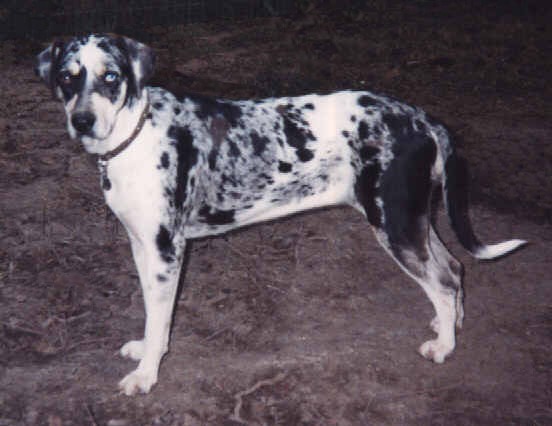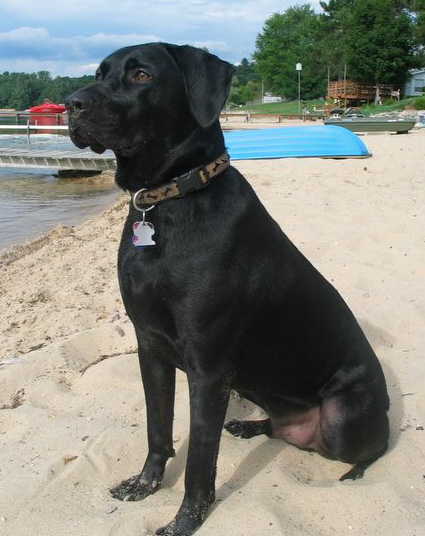



The Catahoula is a medium-large breed. Typically, females are 20"-24" tall and males are 22"-26" tall at the withers. Weight may range from less than 50 to upwards of 90 lbs, depending on height and bone structure. The Catahoula has a very short, smooth, single coat which comes in a wide variety of colors and patterns. Catahoulas are most commonly seen in blue or red merle (leopard) patterns. Other colors seen in the breed include patchwork (a variation of the merle pattern), solid black, solid red/liver, solid blue, yellow, and brindle. Various amounts of tan, brindle, and/or white trim may also be present. The eyes may be any color or combination of colors.
The Catahoula is a highly intelligent, athletic, and assertive breed. They tend to be protective and territorial, guarding their home and family. The Catahoula's versatility as a multi-purpose working dog is unmatched. Catahoulas excel at working livestock, hunting all kinds of wild game, search & rescue, protection, and police work. In the right hands and with sufficient exercise, training, and socialization, they can also make good companions. However, the Catahoula is not a breed for everyone. They generally do not fare well in urban settings. Catahoulas tend to be independent and have a mind of their own. They can be quite stubborn at times, and a challenge to train.
Catahoulas have a distinctive natural working style which sets them apart from other herding & hunting breeds. Unlike hounds, Catahoulas tend to be silent on track. They typically do not bay until their prey is within sight. Catahoulas also tend to be close range hunters, circling back and checking in periodically. When working livestock, Catahoulas circle and bay. They tend to work the head of the animal, where as most herding breeds are heelers. Catahoulas have the grit and tenacity to handle the roughest cattle, as well as wild boar.

Leopard - Refers to the merle color pattern. The merle gene breaks up the dog's color, so that some hairs lack pigment. The overall visual effect is a dilution of color, with some unaffected patches of dense color scattered throughout the coat. The merle pattern is only apparent on black/blue/liver pigment (eumelanin). The merle pattern will not manifest on any areas of the body that express tan (pheomelanin) and/or white trim.
Blue Leopard - Refers to the blue merle color pattern. Blue leopards are genetically black dogs with the merle pattern. Blue leopards are some shade of grey with black patches scattered throughout the coat. Blue leopards may range from mostly light grey to mostly black. Sometimes the terms "grey leopard" or "black leopard" are used.
Red Leopard - Refers to the red merle color pattern. Red leopards are genetically liver colored dogs with the merle pattern. Red leopards are some shade of tan or reddish-brown with darker red/brown patches scattered throughout the coat.
Silver Leopard - Generally refers to a blue dilute with the merle pattern.
Patchwork - There is some variation in usage of this term, but it generally refers to leopards with patches of several different shades in their coats. The background color is sometimes white or very light, and the patches are often large and scattered in such a way as to give a more torn or blotchy appearance than that of a typical leopard. This is a variant of the merle gene.
Phantom Merle/Ghost Merle/Cryptic Merle - Refers to dogs which are genetically merle but phenotypically appear to be solid colored. There has been some variation in usage of these terms as well, but recent discoveries in genetic research have revealed new data regarding cryptic merles. In the strictest traditional sense of the term, a phantom merle shows no external evidence whatsoever of the merle pattern (including small leopard spots and/or glass or partial glass eyes). However, some people will use the terms "phantom" or "ghost" merle in reference to dogs which appear to be mostly solid, but upon closer inspection do have some small/inconspicuous leopard spots and/or glass/cracked glass eyes. Some dogs that are obviously leopards during puppyhood may darken so much with age as to become virtually solid colored in appearance later in life. These are simply dark leopards, not true cryptic merles. Currently, the term cryptic merle generally refers to a variant of the merle gene, which basically is phenotypically indistinguishable from solid.
Double Merle - Refers to dogs which carry two copies of the merle gene (one inherited from each parent). Double merles usually have a significant quantity of white in the coat. Due to the lack of pigmentation, double merles are predisposed to deafness. Eye defects also occur with increased frequency in double merles. Any time that two merles are bred together, there is a risk of producing double merle (and potentially defective) offspring.
Excessive White - This is a very subjective term, and usually refers to double merles. However, excessive white coloration may also be due to the piebald spotting pattern. Some patchworks also have a lot of white in their coats. Due to the lack of pigmentation, excessive whites show an increased incidence of deafness.
Trim White - Refers to white markings which are restricted to one or more of the normal trim areas (blaze face, ring neck, chest, belly, feet, legs, & tail tip).
Glass eyes - Refers to eyes which are blue or blue-white in color. Dogs with two glass eyes are often referred to as having "double glass eyes". Sometimes a glass eye will have some sections of other colors, and vice versa. When both darker colored and glass portions are present in the same eye, the eye is usually called "cracked glass" or "marbled glass". Glass (or partial glass) eyes are usually only present in leopard/merle patterned dogs, but rarely may be produced independently of the merle gene, most notably in piebalds.
Brindle - This color pattern produces dark stripes overlaid on a tan background.
Red - In Catahoulas, "red" usually refers to liver pigmentation. This term can be confusing, as it has varied usage, depending on breed and shade of pigmentation. Geneticists typically use "red" in reference to a totally different type of pigment (for example, the "red" of an Irish Setter is very different genetically than the "red" of a liver colored Catahoula).


|

|

|

|

|
|
|
|
    
|
|
 
|
|
   
|
|
|
   
|






















